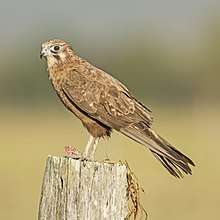Brown falcon
| Brown falcon | |
|---|---|
 | |
| At Ingham, Queensland, Australia | |
| Scientific classification | |
| Kingdom: | Animalia |
| Phylum: | Chordata |
| Class: | Aves |
| Order: | Falconiformes |
| Family: | Falconidae |
| Genus: | Falco |
| Species: | F. berigora |
| Binomial name | |
| Falco berigora | |
| Synonyms | |
|
Asturaetus furcillatus De Vis, 1906 | |

The brown falcon (Falco berigora) is a relatively large falcon native to Australia and New Guinea.
A number of plumage morphs exists, with the primary distinction being between the pale morph and the dark morph. Both morphs usually have dark brown upper parts and wing coverts. Dark morph birds have predominantly dark under parts, although some light streaking is common. Pale morph birds have white under parts that are varyingly streaked with brown, sometimes heavily so. Pale individuals may also have prominently white under tail coverts and these may be diagnostic.
The species name berigora has Aboriginal origins.
Description
Adults are usually 40 to 50 cm (16 to 20 in) long. They are found in light and dark forms and a variety of intermediates. Animals typically have red-brown heads with narrow black streaks with a light crown and off-white chin. Wings are a spotted red-brown with dark brown quills. Beaks are light blue/grey; eyes are brown. The falcons make a loud cackle call uttered frequently.
Breeding and habitat
Brown falcons breed from June to November, usually in an old nest of another hawk species; they occasionally nest in hollow limbs of trees. The brown falcon lays between two and five eggs that have red and brown spots and blotches.
Subspecies
- F. b. novaeguineae : central and eastern New Guinea and coastal northern Australia[2]
- F. b. berigora : Australia (except coastal north) and Tasmania
Diet
The brown falcon eats small mammals, including house mice. They also eat young rabbits in the summer. It also eats small birds, lizards, snakes, and a variety of invertebrates, particularly caterpillars, grasshoppers, crickets, and beetles. Insects form the bulk of the animals' diets during winter and the falcons often chase the insects on the ground.
References
- ↑ BirdLife International (2012). "Falco berigora". IUCN Red List of Threatened Species. Version 2013.2. International Union for Conservation of Nature. Retrieved 26 November 2013.
- ↑ IOC World Bird List
Further reading
- Birds of The World by Colin Harrison and Alan Greensmith
- Complete Book of Australian Birds Readers Digest
Gallery
 John Gould illustration
John Gould illustration Brown falcon portrait
Brown falcon portrait Brown falcon
Brown falcon.jpg) In flight in Victoria, Australia
In flight in Victoria, Australia Adult, pale morph, Tasmania
Adult, pale morph, Tasmania Adult (pale morph) takes flight, Tasmania
Adult (pale morph) takes flight, Tasmania
| Wikimedia Commons has media related to Brown falcon (Falco berigora). |
| Wikispecies has information related to Falco berigora |
